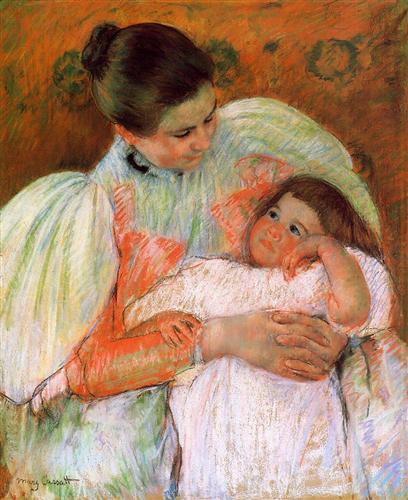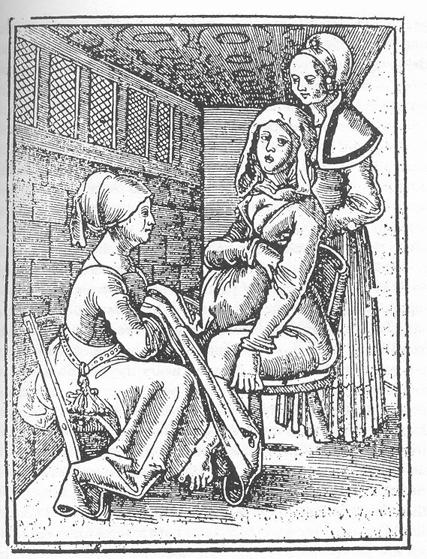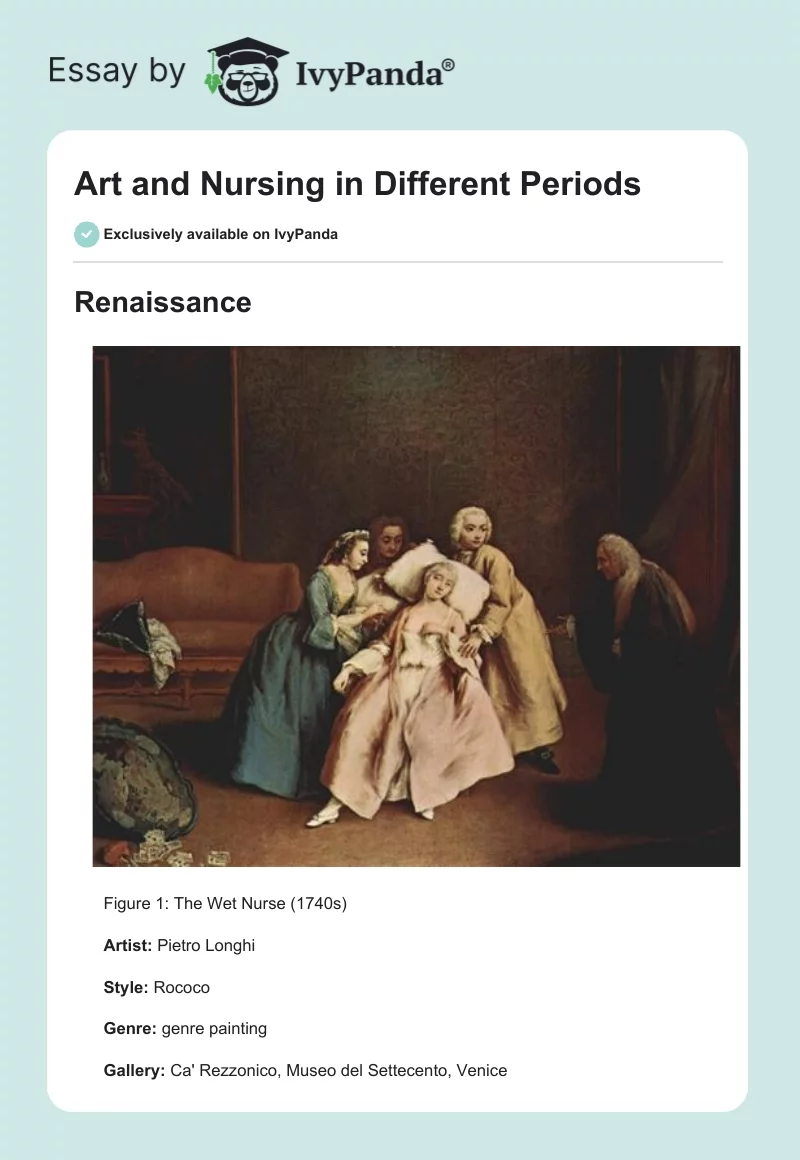Renaissance

Artist: Pietro Longhi
Style: Rococo
Genre: genre painting
Gallery: Ca’ Rezzonico, Museo del Settecento, Venice
Impressionism

Artist: Mary Cassatt
Start Date: 1896
Completion Date: 1897
Style: Impressionism
Genre: genre painting
Technique: pastel
Material: paper
Gallery: Metropolitan Museum of Art, New York City
Medieval

The proposal
One intriguing aspect of these works of fine art is that they capture history of nursing and the role of nurses during earlier periods. One may think that nursing roles were nonexistent during these periods, but the selected arts of Renaissance, Impressionism and Medieval Age show otherwise. There have been nurses with diverse roles since early periods and perhaps the profession is older than imagined.
The Renaissance painting, the Wet Nurse by Pietro Longhi, the medieval woodcut, the Childbirth by Eucharius Rösslin, and the Impressionism painting, Nurse and Child by Mary Cassatt show that nurses already had specialized roles as care providers. In fact, in all the examples used, women provided nursing care to their patients. This shows that women were always central in providing care for the sick, babies or nursing adults. These works for fine arts show the evolution of nursing and medical profession.
Training for nurses was not formal and many deaths were associated with some care provided. Nevertheless, it is believed that nurses started to provide patient care in earlier periods and significantly improved healthcare outcomes because of their roles in enhancing sanitation and giving effective nursing care. In addition, some of their roles were diverse and many including washing, dressing, laundry and cooking among others. The overall theme in these works of arts shows the caring nature of nursing.
Information and Description
The Renaissance period was characterized by increased activities of wet nurses. The Wet Nurse (1740s) by Pietro Longhi aims to depict the role of nurses during this period. The painting shows a case of childbirth in which wet nurses had to play critical roles. The practice of wet nurse was common in France and it later spread to the British Isles.
During the impressionism period, the practices of wet nurse persisted. However, this portrait shows that women preferred to take care of children instead of breast-feeding. The services offered by wet nurses were paid and in turn, nurses cared for and fed children using their own breast milk.
It is noteworthy that in some instances, poor care was common and could result into deaths of children. Only those who could afford services of wet nurses could send their children to them. It remains unclear why mothers preferred to send their children to be breastfed by wet nurses. In fact, it seems that services provided by wet nurses in childcare were necessity.
Given these events, it is clear that mothers had to stop their own flow of milk using some sort of medicine while wet nurses had to ensure continued flow of milk. Diets and certain medications could have been used to discourage or facilitate lactation in women.
However, developments in scientific studies had recommended that mothers should breastfed their own children rather than using services of wet nurses. In short, historically, feeding of children has evolved from wet nursing, bottle-feeding to the current formula used (Stevens et al., 2009).
Nurses also had critical roles to play in the medial period. For instance, they took part in childbirth. During medieval period, the role of nurses was evident during childbirth as depicted by woodcut, the Childbirth by Eucharius Rösslin, 1513. Women actively took part in childbirth with male physicians during this period.
Although male physicians attended to some women during childbirth, midwives, maids, or nurses were employed to do any manual examination (Heise, 2003). Nurses offered care services related to pregnancy complications, including breast and swollen feet care.
The woodcut art provides the best documentation of childbirth and aftercare of individuals involved. It also shows that nurses and physicians have always collaborated to deliver quality care to their patients.
How these three works connect to the nursing profession
These three works of fine arts reflect compassionate care role provided by nurses. Nursing has always been regarded as a caring profession, and this true as reflected in the three works covered. These works of arts were used to capture caring nature of nursing. Thus, caring and nursing could be difficult to separate.
Nurses choose nursing profession because of their inner drive to provide care for others who cannot meet their own needs. Today, the concept of caring in nursing has led to development of many theories to reflect compassionate nature of nurses (Vance, 2003).
Generally, the aim of nursing has always been to provide care for others by ensuring that they achieve a state of well-being in mind, soul and body. Caring transactions occur when nurses interact with patients. Nurses believe in the patient care because of the hope that they will enhance health outcomes and cure.
However, the roles of today’s nurse are rapidly changing beyond bedside care. Nurses have even greater roles and responsibilities since providing care has become complicated because of complex nature of diseases, few staff and fewer resources. For instance, expansion caused by the healthcare reforms, the Affordable Care Act, has resulted in a large number of individuals who can gain access to healthcare. There are no adequate primary physicians to care for such patients. This is a pressing issue, and nurses are expected to take up these roles.
From the three works of art, caring was the main role of nurses. Today, however, nursing has evolved and therefore caring for the sick is just a part of nurse roles. Nurses have continued to define modern medicine and healthcare delivery because they have continued to collaborate with their colleagues, shape policies and even take part in nurse education and training.
Why these specific selections
The three pieces of art works were selected because they all depicted caring nature of nursing. Thus, they show that caring is the central concept that guides nursing profession. Researchers must also strive to understand how caring continues to influence aspects of nursing and nursing practices as they evolve.
Nurses care because it is inherent in the profession, and they develop it deeply with experience (Pires & Goes, 2008). It is an intentional role and reflects attitudes of nurses toward their patients. Caring shapes the relationship between nurses and their patients. Therefore, nurses should continue to evaluate the concept of caring in order to understand its processes so that they can improve quality of care and patient outcomes.
Caring model in nursing has been applied to demonstrate the humanistic nature of nursing and has traditionally remained the main core of nursing profession.
References
Heise, J. A. (2003). Women and Medicine in the Middle Ages and Renaissance. Web.
Pires, A., & Goes, M. (2008). Caring: a fundamental concept in nursing. A review of literature. Servir, 56(5-6), 184-8.
Stevens, E. E., Patrick, T. E., & Pickler, R. (2009). A History of Infant Feeding. Journal of Perinatal Education, 18(2), 32–39. doi: 10.1624/105812409X426314.
Vance, T. (2003). Caring and the Professional Practice of Nursing. Web.


